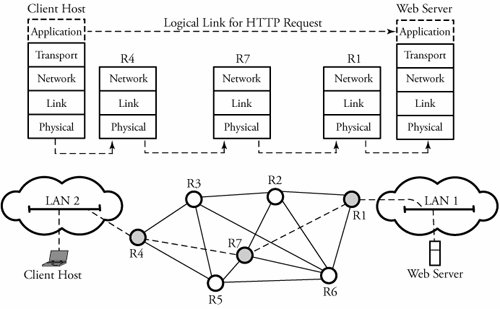Section 9.1. Application-Layer Overview
9.1. Application-Layer OverviewThe application layer is built on the transport layer and provides network services to user applications. The application layer defines and performs such applications as electronic mail (e-mail), remote access to computers, file transfers, newsgroups, and the Web, as well as streaming video, Internet radio and telephony, P2P file sharing, multiuser networked games , streaming stored video clips, and real-time video conferencing. The application layer has its own software dependencies. When a new application is developed, its software must be able to run on multiple machines, so that it does not need to be rewritten for networking devices, such as routers, that function at the network layer. In a client/server architecture for example, a client end host requests services from a server host. A client host can be on sometimes or always. Figure 9.1 shows an example of application-layer communication. Figure 9.1. Web communication between two end systems 9.1.1. Client and Server ModelA client/server model provides specific computational services, such as partial-time usage services to multiple machines. Reliable communication protocols, such as TCP, allow interactive use of remote servers as well. For example, we can build a server that provides remote image-processing services to clients . Implementing such a communication service requires a server loaded with the application protocol to accept requests and a client to make such requests. To invoke remote image processing, a user first executes a client program establishing a TCP connection to a server. Then, the client begins transmitting pieces of a raw image to the server. The server processes the received objects and sends the results back. |
EAN: 2147483647
Pages: 211